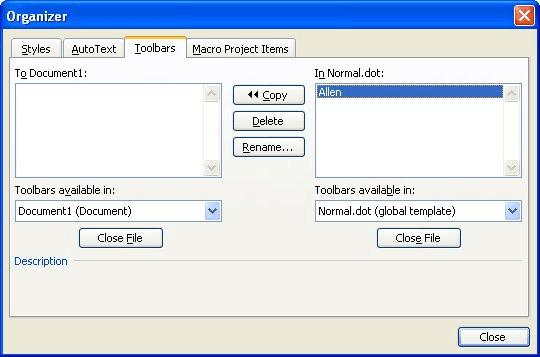Written by Allen Wyatt (last updated August 26, 2023)
This tip applies to Word 97, 2000, 2002, and 2003
You already know that Word allows you to extensively customize toolbars, or even to create your own toolbars. (The procedures to do these tasks have been covered in past issues of WordTips.) You may not know, however, that custom toolbars (the new ones you create) are stored in a document and can be stored with a template.
Developing custom toolbars can be particularly time-consuming. Fortunately, you can use the Organizer to copy toolbars from one document or template to another. You can also use it to delete or rename toolbars, although you may already know how to perform those tasks in other ways. To manage your toolbars, follow these steps:

Figure 1. The Toolbars tab of the Organizer.
WordTips is your source for cost-effective Microsoft Word training. (Microsoft Word is the most popular word processing software in the world.) This tip (1352) applies to Microsoft Word 97, 2000, 2002, and 2003.

Create Custom Apps with VBA! Discover how to extend the capabilities of Office 365 applications with VBA programming. Written in clear terms and understandable language, the book includes systematic tutorials and contains both intermediate and advanced content for experienced VB developers. Designed to be comprehensive, the book addresses not just one Office application, but the entire Office suite. Check out Mastering VBA for Microsoft Office 365 today!
If you use Word's versioning tool, you may notice that you sometimes get errors with the versions in your documents. This ...
Discover MoreWord provides a handy wizard that is helpful in creating basic letters quickly and easily. This tip discusses the Letter ...
Discover MoreTips for using the Discussion pane during a Discussion session.
Discover MoreFREE SERVICE: Get tips like this every week in WordTips, a free productivity newsletter. Enter your address and click "Subscribe."
There are currently no comments for this tip. (Be the first to leave your comment—just use the simple form above!)
Got a version of Word that uses the menu interface (Word 97, Word 2000, Word 2002, or Word 2003)? This site is for you! If you use a later version of Word, visit our WordTips site focusing on the ribbon interface.
Visit the WordTips channel on YouTube
FREE SERVICE: Get tips like this every week in WordTips, a free productivity newsletter. Enter your address and click "Subscribe."
Copyright © 2025 Sharon Parq Associates, Inc.
Comments